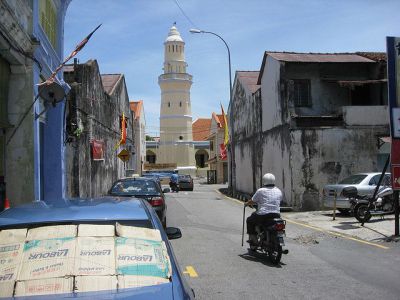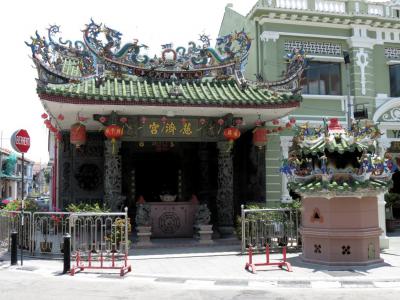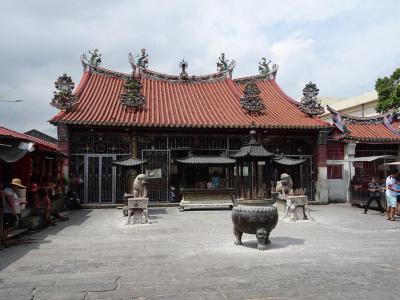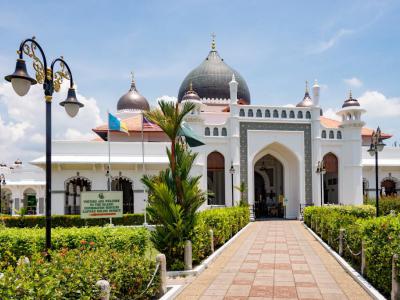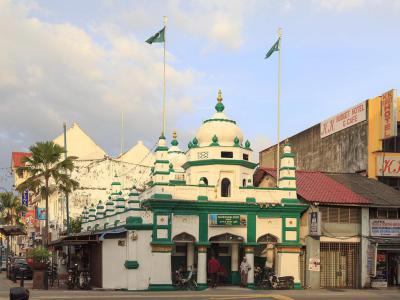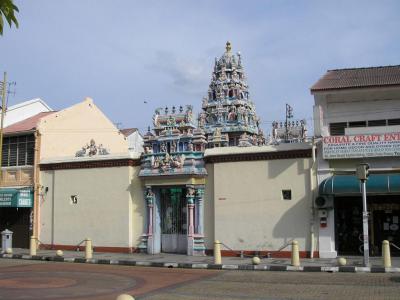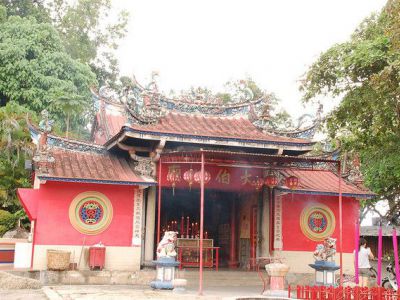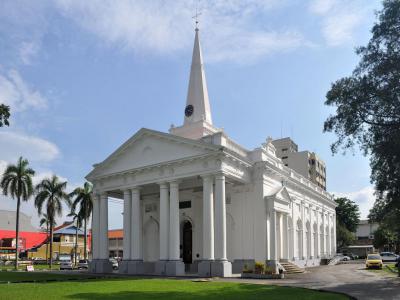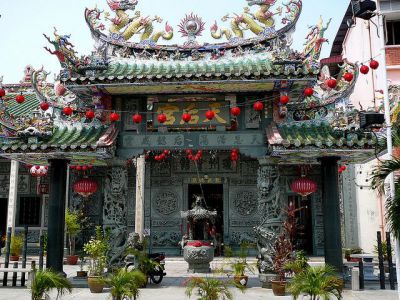George Town's Historical Religious Buildings (Self Guided), George Town
George Town, Malaysia, has much to be proud of when it comes to religious heritage. The city boasts a plethora of wonderful churches, temples, mosques, and other religious sites – each beautifully decorated and with its own unique story. Follow us on this self-guided walk and see some of them up close.
We start at the Acheen Street Mosque. Dating back to the early 19th century, this is one of the oldest mosques in Penang. Its architecture is a blend of Moorish and Sumatran influences.
Our next stop is the Yap Kongsi Temple. This temple is a Chinese clan house whose intricate wood carvings and traditional Chinese architecture have made it one of the city's UNESCO World Heritage sites.
Continuing our walk, we arrive at the Goddess of Mercy Temple, a serene Buddhist shrine dedicated to the Goddess of Mercy, Kuan Yin.
Nearby is another historical gem, the Kapitan Keling Mosque. Built by Indian Muslim traders in the early 19th century, this fine piece of Indo-Moorish architecture is a significant addition to the religious scene of George Town.
Further ahead we will find the Nagore Durgha Shrine, an elegant Muslim sanctuary dedicated to a 16th-century South Indian saint.
Sri Mariamman Temple, a striking Hindu place of worship adorned with colorful sculptures and intricate designs, showcases the vibrant Tamil community's religious traditions.
The Cantonese Tua Pek Kong Temple, nestled within the bustling Chinatown, is dedicated to the Taoist deity, the God of Prosperity. Its stunning artwork has also earned it a place among George Town's UNESCO World Heritage Sites.
A few blocks away, Saint George's Church, is a beautiful Anglican church standing as a fine example of British colonial architecture and a symbol of the city's colonial past.
Our final stop on this walk is the Hainan Temple, dedicated to the Sea Goddess Mazu, reflecting the unique Hainanese community's spiritual practices.
Visiting these historical sanctuaries in George Town is a remarkable journey through its multicultural heritage and vibrant history. We hereby encourage you to explore these sites and experience the spiritual and architectural diversity that makes George Town truly special.
We start at the Acheen Street Mosque. Dating back to the early 19th century, this is one of the oldest mosques in Penang. Its architecture is a blend of Moorish and Sumatran influences.
Our next stop is the Yap Kongsi Temple. This temple is a Chinese clan house whose intricate wood carvings and traditional Chinese architecture have made it one of the city's UNESCO World Heritage sites.
Continuing our walk, we arrive at the Goddess of Mercy Temple, a serene Buddhist shrine dedicated to the Goddess of Mercy, Kuan Yin.
Nearby is another historical gem, the Kapitan Keling Mosque. Built by Indian Muslim traders in the early 19th century, this fine piece of Indo-Moorish architecture is a significant addition to the religious scene of George Town.
Further ahead we will find the Nagore Durgha Shrine, an elegant Muslim sanctuary dedicated to a 16th-century South Indian saint.
Sri Mariamman Temple, a striking Hindu place of worship adorned with colorful sculptures and intricate designs, showcases the vibrant Tamil community's religious traditions.
The Cantonese Tua Pek Kong Temple, nestled within the bustling Chinatown, is dedicated to the Taoist deity, the God of Prosperity. Its stunning artwork has also earned it a place among George Town's UNESCO World Heritage Sites.
A few blocks away, Saint George's Church, is a beautiful Anglican church standing as a fine example of British colonial architecture and a symbol of the city's colonial past.
Our final stop on this walk is the Hainan Temple, dedicated to the Sea Goddess Mazu, reflecting the unique Hainanese community's spiritual practices.
Visiting these historical sanctuaries in George Town is a remarkable journey through its multicultural heritage and vibrant history. We hereby encourage you to explore these sites and experience the spiritual and architectural diversity that makes George Town truly special.
How it works: Download the app "GPSmyCity: Walks in 1K+ Cities" from Apple App Store or Google Play Store to your mobile phone or tablet. The app turns your mobile device into a personal tour guide and its built-in GPS navigation functions guide you from one tour stop to next. The app works offline, so no data plan is needed when traveling abroad.
George Town's Historical Religious Buildings Map
Guide Name: George Town's Historical Religious Buildings
Guide Location: Malaysia » George Town (See other walking tours in George Town)
Guide Type: Self-guided Walking Tour (Sightseeing)
# of Attractions: 9
Tour Duration: 1 Hour(s)
Travel Distance: 1.8 Km or 1.1 Miles
Author: Maia
Sight(s) Featured in This Guide:
Guide Location: Malaysia » George Town (See other walking tours in George Town)
Guide Type: Self-guided Walking Tour (Sightseeing)
# of Attractions: 9
Tour Duration: 1 Hour(s)
Travel Distance: 1.8 Km or 1.1 Miles
Author: Maia
Sight(s) Featured in This Guide:
- Lebuh Aceh Mosque
- Yap Kongsi Temple
- Kuan Yin Teng (Goddess of Mercy Temple)
- Kapitan Keling Mosque
- Nagore Durgha Shrine
- Sri Mariamman Temple
- Cantonese Tua Pek Kong Temple
- St. George's Anglican Church
- Hainan Temple
1) Lebuh Aceh Mosque
Lebuh Aceh was constructed in the 19th century by the Acehnese community who migrated to Penang from Aceh, Indonesia, during the British colonial era. Architecturally, it reflects a unique blend of Malay, Acehnese, and Moorish influences, featuring traditional Malay motifs, intricate carvings, and a distinctive minaret that stands tall against the skyline. Within its premises lies the mausoleum of the founder, Tengku Syed Hussain Idid, featuring simple tombstones sheltered under a modest structure. The surrounding residences, remnants of the original Muslim settlement, showcase charming 19th-century bungalows still inhabited by descendants of the founders.
Historically, the settlement earned the moniker "Second Jeddah," serving as a gathering point for pilgrims preparing to embark on their journey to Mecca by sea. During the Haj season, Lebuh Acheh witnessed a bustling influx of pilgrims and their families. Today, it welcomes visitors, offering them the freedom to explore its surroundings.
Historically, the settlement earned the moniker "Second Jeddah," serving as a gathering point for pilgrims preparing to embark on their journey to Mecca by sea. During the Haj season, Lebuh Acheh witnessed a bustling influx of pilgrims and their families. Today, it welcomes visitors, offering them the freedom to explore its surroundings.
2) Yap Kongsi Temple
Built by the Yap clan, one of Penang's oldest and most prominent Hokkien clans, this temple venerates the deity Tua Sai Yah. Construction commenced in the 1920s and reached completion in the early 1930s – complete with elaborate carvings, intricate ceramic tile work, and vibrant roof decorations, blending elements of Art Deco with the distinct Straits Chinese style.
Blue dragons, a green roof, and walls decorated with pearls can all be admired here. Of particular note are three porcelain figures atop the roof, symbolizing luck, wealth, and health-a motif replicated in apartments and eateries throughout the city.
While access may be limited, visitors can often explore the adjacent Choo Chay Keong, built in a more traditional "kongsi" style.
Blue dragons, a green roof, and walls decorated with pearls can all be admired here. Of particular note are three porcelain figures atop the roof, symbolizing luck, wealth, and health-a motif replicated in apartments and eateries throughout the city.
While access may be limited, visitors can often explore the adjacent Choo Chay Keong, built in a more traditional "kongsi" style.
3) Kuan Yin Teng (Goddess of Mercy Temple)
Established in 1801 by early Chinese immigrant settlers, Kuan Yin Teng is one of Penang's oldest and most revered Chinese temples. Dedicated to the Chinese goddess of mercy, Kuan Yin, the central hall houses her statue, symbolizing benevolence and boundless compassion accessible to all. Statues of the goddess, often draped in white robes, are a common sight in homes and Buddhist temples.
Architecturally, the temple harmoniously blends Chinese and Southeast Asian influences, featuring a grand roof adorned with decorated copings and ridges. Its main entrance is embellished with elaborate carvings and vibrant ceramic tiles, while the interior showcases ornate altars, deity statues, and exquisite woodwork. Noteworthy are a pair of stone sculptured lions, known as Fu dogs.
On auspicious days, such as the first and fifteenth day of lunar calendar months, devotees of all ages gather to offer joss sticks, flowers, and burn sandalwood incense as they pray for health, wealth, fertility, and longevity. Additionally, the temple's adjacent square serves as a venue for puppet shows and Chinese operas during special occasions.
Architecturally, the temple harmoniously blends Chinese and Southeast Asian influences, featuring a grand roof adorned with decorated copings and ridges. Its main entrance is embellished with elaborate carvings and vibrant ceramic tiles, while the interior showcases ornate altars, deity statues, and exquisite woodwork. Noteworthy are a pair of stone sculptured lions, known as Fu dogs.
On auspicious days, such as the first and fifteenth day of lunar calendar months, devotees of all ages gather to offer joss sticks, flowers, and burn sandalwood incense as they pray for health, wealth, fertility, and longevity. Additionally, the temple's adjacent square serves as a venue for puppet shows and Chinese operas during special occasions.
4) Kapitan Keling Mosque
Masjid Kapitan Keling is the most famous mosque in Penang. Its architecture combines the Indian-Mughal style with Gothic, Moorish, Romanesque and Renaissance elements. The mosque is named for Cauder Mohudeen Merican. Commonly called Kapitan Keling, he was the leader of the Muslim community in Penang in the early 19th century.
Sir George Leigh, Lieutenant-Governor of Penang, granted 18 acres of land for the mosque in 1801. The mosque was designed by German architect Henry Alfred Neubronner. It is located on Kapitan Keiling Street, also called "the Street Of Harmony." The mosque shares the Street with the Goddess of Mercy Temple and Saint George's Church.
The mosque is part of the World Heritage Site of George Town. It is at the center of the Tamil Muslim Chulias Neighborhood. Cauder Mohudeen was a ship tandoor from Porto Novo, south of Pondicherry, India.
The original design met with disapproval and the mosque was remodeled and enlarged. The prayer hall doubled in height. The ventilation system was overhauled and more natural light was admitted. The outside is colored ochre. The interior has white marble floors. The aisles are framed by horseshoe arches. All decoration is of geometrical designs.
Sir George Leigh, Lieutenant-Governor of Penang, granted 18 acres of land for the mosque in 1801. The mosque was designed by German architect Henry Alfred Neubronner. It is located on Kapitan Keiling Street, also called "the Street Of Harmony." The mosque shares the Street with the Goddess of Mercy Temple and Saint George's Church.
The mosque is part of the World Heritage Site of George Town. It is at the center of the Tamil Muslim Chulias Neighborhood. Cauder Mohudeen was a ship tandoor from Porto Novo, south of Pondicherry, India.
The original design met with disapproval and the mosque was remodeled and enlarged. The prayer hall doubled in height. The ventilation system was overhauled and more natural light was admitted. The outside is colored ochre. The interior has white marble floors. The aisles are framed by horseshoe arches. All decoration is of geometrical designs.
5) Nagore Durgha Shrine
Constructed at the dawn of the 19th Century, Nagore Durgha venerates Syed Shahul Hamid, a 13th-century Muslim saint from Nagore, India – a testament to the enduring legacy of Tamil Muslim traders who settled in Penang, bringing with them the tradition of the saint.
Regarded as the oldest Muslim Indian shrine in Penang with its original structure impeccably preserved, Nagore Durgha showcases distinctive South Indian architectural influences. Its rectangular layout features small, tapered minarets at each corner, separated by delicate lattice screens, while a "burji" denotes the plinth level of the edifice.
Welcoming worshippers through a portico with four arches, the front entrance leads to the prayer hall, featuring two onion-shaped domes crowned by inverted lotuses and Indian "kalashas". An adjacent wall features a built-in arcade, home to various shops offering Muslim prayer essentials, jewelry, and the traditional "songkok" headgear worn by males.
Remaining a focal point of religious devotion for Indian Muslims of Tamil descent, the shrine commemorates feast days with ceremonies marked by the distribution of food and the raising of flags, perpetuating the spiritual and cultural heritage of its founders.
Regarded as the oldest Muslim Indian shrine in Penang with its original structure impeccably preserved, Nagore Durgha showcases distinctive South Indian architectural influences. Its rectangular layout features small, tapered minarets at each corner, separated by delicate lattice screens, while a "burji" denotes the plinth level of the edifice.
Welcoming worshippers through a portico with four arches, the front entrance leads to the prayer hall, featuring two onion-shaped domes crowned by inverted lotuses and Indian "kalashas". An adjacent wall features a built-in arcade, home to various shops offering Muslim prayer essentials, jewelry, and the traditional "songkok" headgear worn by males.
Remaining a focal point of religious devotion for Indian Muslims of Tamil descent, the shrine commemorates feast days with ceremonies marked by the distribution of food and the raising of flags, perpetuating the spiritual and cultural heritage of its founders.
6) Sri Mariamman Temple
Established in the 1830s by early Indian settlers in Penang, Sri Mariamman is the oldest and largest Hindu temple in the region. Initially a modest wooden structure intended to serve the burgeoning Hindu community, it underwent successive renovations and expansions, culminating in the grand complex seen today.
Architecturally, the temple exhibits a captivating fusion of South Indian and Dravidian styles. Its colorful facade is adorned with intricate carvings, sculptures depicting Hindu deities, and ornate embellishments, showcasing the artistic heritage of South India. The towering "gopuram", or entrance tower, is particularly striking, with elaborate sculptures and vivid paintings depicting tales from Hindu mythology.
Within the interior lies the statue of Lord Subramaniam, bedecked with gold, silver, diamonds, and emeralds. This revered statue plays a central role in the annual Thaipusam festival, where it is paraded through the streets on a silver chariot. Meanwhile, the central sanctum, housing the primary deity, Mariamman, is adorned with flowers, garlands, and offerings brought by devotees seeking solace.
Visitors are reminded to remove their shoes before entering and refrain from taking photos out of respect for the sacred space.
Architecturally, the temple exhibits a captivating fusion of South Indian and Dravidian styles. Its colorful facade is adorned with intricate carvings, sculptures depicting Hindu deities, and ornate embellishments, showcasing the artistic heritage of South India. The towering "gopuram", or entrance tower, is particularly striking, with elaborate sculptures and vivid paintings depicting tales from Hindu mythology.
Within the interior lies the statue of Lord Subramaniam, bedecked with gold, silver, diamonds, and emeralds. This revered statue plays a central role in the annual Thaipusam festival, where it is paraded through the streets on a silver chariot. Meanwhile, the central sanctum, housing the primary deity, Mariamman, is adorned with flowers, garlands, and offerings brought by devotees seeking solace.
Visitors are reminded to remove their shoes before entering and refrain from taking photos out of respect for the sacred space.
7) Cantonese Tua Pek Kong Temple
Recipient of the 2021 UNESCO Asia Pacific Awards for Cultural Heritage Conservation, this Taoist temple stands as another testament to Penang's rich cultural tapestry, tracing its roots back to 1810. Believed to be the second oldest Chinese temple in George Town (following only the Kuan Im Teng), it holds a significant place in the region's religious and historical narrative.
Tua Pek Kong, within the Penang context, is revered as a deified representation of Tudigong, believed to be Zhang Li, a Hakka descendant who arrived in the Malay peninsula in the mid-18th century. Following a fortuitous diversion to Penang during a storm en route to Sumatra, his arrival marked the genesis of Tua Pek Kong worship among the local Chinese community. Symbolizing prosperity and revered as the god of wealth, shrines dedicated to Tua Pek Kong proliferated throughout Malaysia and Singapore.
Distinguished by its Hokkien-style architecture, the temple in George Town showcases intricate roof ornamentation and sloping rafters decorated with "Chien Nien" broken pottery motifs depicting dragons and figurines. The striking red facade, divided into three bays with ornate windows in the central bay, adds to its visual allure. Adjacent side bays serve as living quarters, featuring a simpler design.
Tua Pek Kong, within the Penang context, is revered as a deified representation of Tudigong, believed to be Zhang Li, a Hakka descendant who arrived in the Malay peninsula in the mid-18th century. Following a fortuitous diversion to Penang during a storm en route to Sumatra, his arrival marked the genesis of Tua Pek Kong worship among the local Chinese community. Symbolizing prosperity and revered as the god of wealth, shrines dedicated to Tua Pek Kong proliferated throughout Malaysia and Singapore.
Distinguished by its Hokkien-style architecture, the temple in George Town showcases intricate roof ornamentation and sloping rafters decorated with "Chien Nien" broken pottery motifs depicting dragons and figurines. The striking red facade, divided into three bays with ornate windows in the central bay, adds to its visual allure. Adjacent side bays serve as living quarters, featuring a simpler design.
8) St. George's Anglican Church
Named after England's patron saint, Saint George's Anglican Church holds the distinction of being the oldest purpose-built Anglican church in Southeast Asia. Constructed in 1818 using convict labor, the edifice was designed by Captain Robert Smith, incorporating elements of Neo-Classical, Georgian, and English Palladian architectural styles. Its exterior presents a simple yet elegant façade, with Doric columns and a triangular pediment, while the interior features a spacious nave, stained glass windows, and a finely crafted wooden ceiling. Recognized as one of Malaysia's 50 National Treasures by the federal government in 2007, the church underwent significant restoration work in 2009 and was elevated to the status of pro-cathedral in 2023.
Beyond its religious and historical significance, Saint George's is celebrated for its picturesque surroundings, nestled amidst verdant greenery and historic edifices. The serene ambiance and scenic locale attract visitors eager to delve into Penang's rich cultural heritage.
Beyond its religious and historical significance, Saint George's is celebrated for its picturesque surroundings, nestled amidst verdant greenery and historic edifices. The serene ambiance and scenic locale attract visitors eager to delve into Penang's rich cultural heritage.
9) Hainan Temple
Founded in the late 19th century, this Hainanese-style temple pays homage to Mar Chor Poh, also known as Mazu, revered as the patron saint of seafarers. Dubbed the "Temple of Heavenly Queen", it underwent extensive remodeling for its centenary celebration in 1995, rejuvenating its distinctive swirling dragon pillars and enhancing the ornamental stone carvings, each detail a masterpiece of artistry.
Venturing inside, visitors are enveloped in a serene ambiance, with verdant trees gracing the central courtyard, alongside a central pavilion where worshippers can pay their respects and offer prayers. Upon entering, one's gaze is drawn upward to an altar dedicated to Guan Gong, while below, an incense burner exudes fragrant offerings, further enriching the spiritual atmosphere.
The temple's annual celebrations, including the birthday of Mazu and other traditional Chinese festivals, are marked by colorful processions, elaborate rituals, and cultural performances that showcase the vibrant traditions of the Hainanese community.
Venturing inside, visitors are enveloped in a serene ambiance, with verdant trees gracing the central courtyard, alongside a central pavilion where worshippers can pay their respects and offer prayers. Upon entering, one's gaze is drawn upward to an altar dedicated to Guan Gong, while below, an incense burner exudes fragrant offerings, further enriching the spiritual atmosphere.
The temple's annual celebrations, including the birthday of Mazu and other traditional Chinese festivals, are marked by colorful processions, elaborate rituals, and cultural performances that showcase the vibrant traditions of the Hainanese community.
Walking Tours in George Town, Malaysia
Create Your Own Walk in George Town
Creating your own self-guided walk in George Town is easy and fun. Choose the city attractions that you want to see and a walk route map will be created just for you. You can even set your hotel as the start point of the walk.
Farquhar Street Walking Tour
Farquhar Street, a UNESCO World Heritage site since 2008, is a culturally rich thoroughfare in George Town, Malaysia, and home to many interesting historic properties. Let's take a brief journey down this storied street and see what they are.
At the outset of Farquhar stands the impressive Supreme Court building, a symbol of justice and governance in Penang. Just a stone's throw away,... view more
Tour Duration: 2 Hour(s)
Travel Distance: 2.4 Km or 1.5 Miles
At the outset of Farquhar stands the impressive Supreme Court building, a symbol of justice and governance in Penang. Just a stone's throw away,... view more
Tour Duration: 2 Hour(s)
Travel Distance: 2.4 Km or 1.5 Miles
George Town Introduction Walking Tour
Some felt in Malaya that the city of George Town should be renamed Tanjung Penaga ("Cape Penaga"). That was the name of the area where George Town now stands. But the Chinese, British, Muslim, Malay and Indian movers and shakers of the town wisely declined. It might be bad for business.
Captain Francis Light, R. N., came to Tanjung Penaga in 1786. He wanted to set up an entrepôt for... view more
Tour Duration: 2 Hour(s)
Travel Distance: 3.3 Km or 2.1 Miles
Captain Francis Light, R. N., came to Tanjung Penaga in 1786. He wanted to set up an entrepôt for... view more
Tour Duration: 2 Hour(s)
Travel Distance: 3.3 Km or 2.1 Miles
The Most Popular Cities
/ view all



